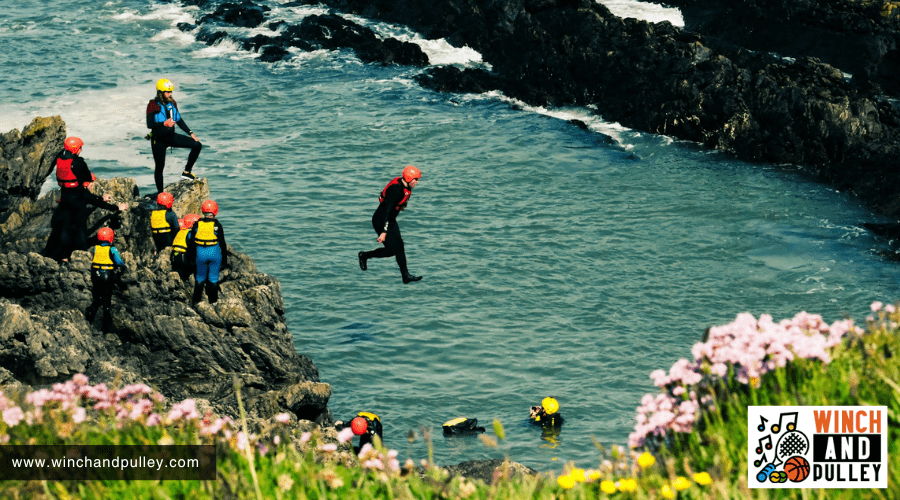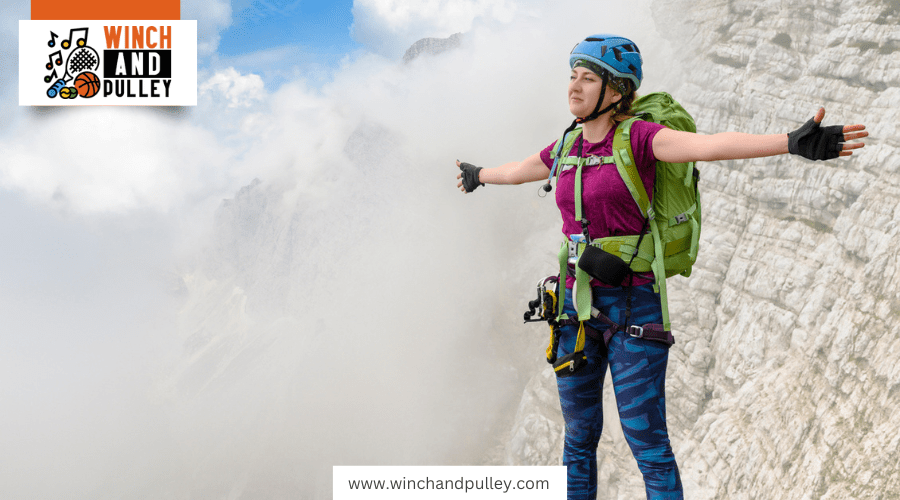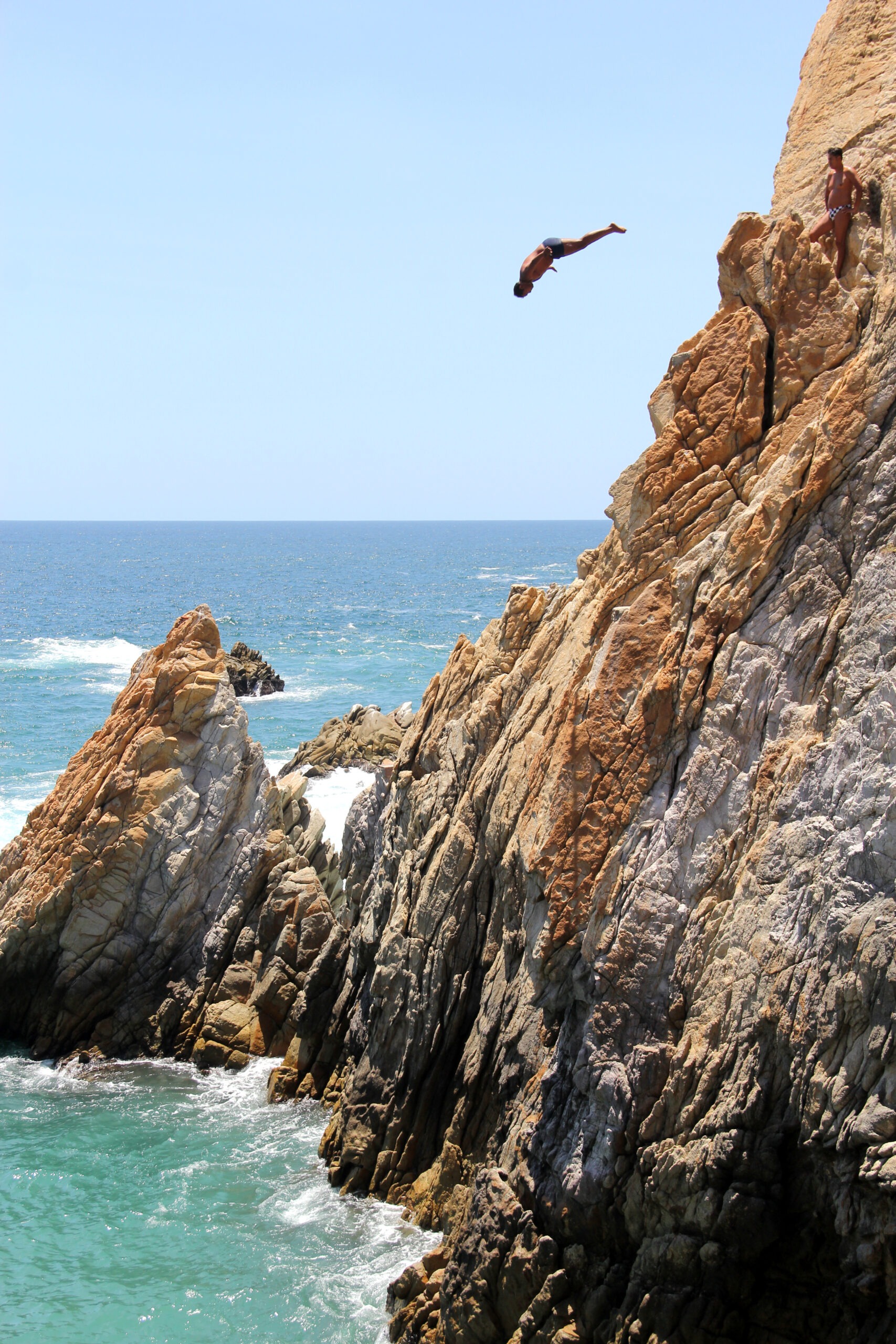What's the Difference Between Cliff Diving and Cliff Jumping?
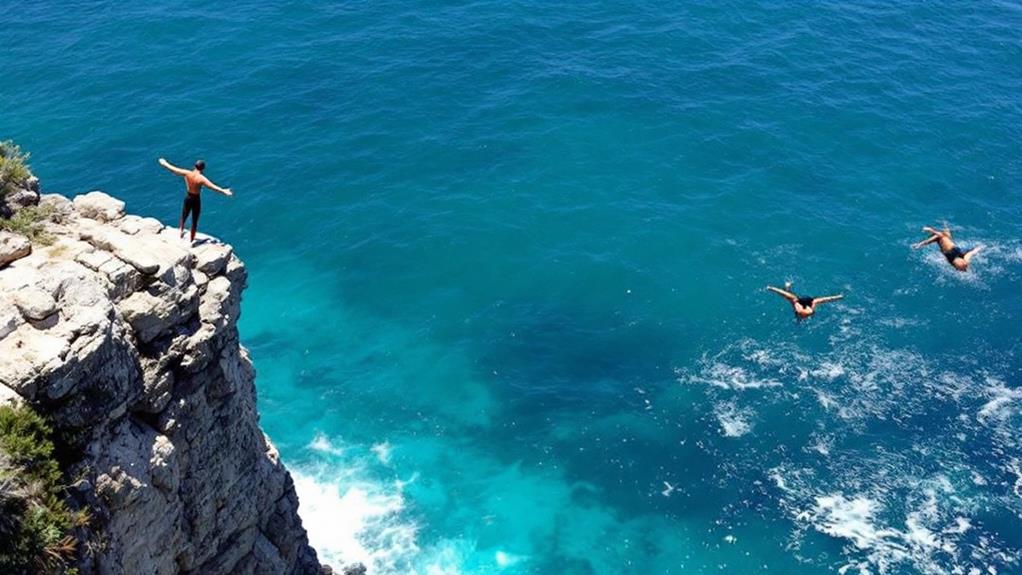
Cliff diving and cliff jumping are both thrilling water activities, but they differ significantly. Cliff diving involves complex acrobatics from greater heights (20-30 meters), requiring advanced skills and professional-level abilities. You'll need extensive training to master the precise techniques and aerial maneuvers. In contrast, cliff jumping is more accessible, typically done from lower heights (5-20 meters) with a simpler feet-first entry. It doesn't demand the same level of expertise but still requires basic swimming skills and physical fitness. While cliff diving has organized competitions with judging criteria, cliff jumping is more informal and focused on personal enjoyment. Understanding these distinctions will help you choose the right adventure for your skill level.
Defining Cliff Diving
Acrobatics meets adrenaline in the exhilarating sport of cliff diving. This extreme activity involves diving from high platforms or natural cliffs into bodies of water, combining elements of gymnastics, diving, and freestyle aerial skills. As a cliff diver, you'll execute complex maneuvers during your descent, aiming to create a visually impressive performance before entering the water. Cliff diving's ancient origins can be traced back to the Hawaiian Islands, where it was known as Lele Kawa, and was later popularized by King Kahekili II of Maui in the late 1700s.
Cliff diving is characterized by its emphasis on technique, form, and artistic expression. You'll need to master various twists, somersaults, and rotations to compete at a high level. Unlike regular diving, cliff diving takes place at much greater heights, typically ranging from 20 to 30 meters (65 to 98 feet). This increased elevation adds an extra layer of challenge and risk to the sport.
Professional cliff diving competitions, such as the Red Bull Cliff Diving World Series, have standardized rules and scoring systems. Judges evaluate divers based on factors like take-off, execution of maneuvers, and entry into the water. To excel in cliff diving, you'll need a combination of physical strength, mental fortitude, and precise body control. It's a sport that demands dedication, practice, and a healthy respect for the dangers involved.
Understanding Cliff Jumping
While cliff diving emphasizes technique and artistry, cliff jumping takes a more straightforward approach to the thrill of leaping from heights. You'll find that cliff jumping is more accessible to beginners and doesn't require the same level of training or expertise as cliff diving. It's all about the rush of free-falling and the splash at the end.
When you're cliff jumping, you'll typically launch yourself feet-first into the water below. The focus is on the jump itself and the exhilaration of the fall, rather than executing specific maneuvers or poses. You'll often see cliff jumpers at natural swimming holes, waterfalls, or coastal cliffs where the water is deep enough for a safe landing. Cliff swinging is another extreme sport that provides a similar adrenaline rush, where participants leap from a cliff and experience a free-fall before the swing catches them.
Safety is still crucial in cliff jumping. You'll need to check water depth, look for submerged obstacles, and consider your landing spot before taking the leap. Unlike cliff diving competitions, cliff jumping is usually a recreational activity without formal judging or scoring. It's a popular adventure sport that attracts thrill-seekers of various skill levels, offering an adrenaline rush without the need for complex techniques or specialized training.
Height Differences
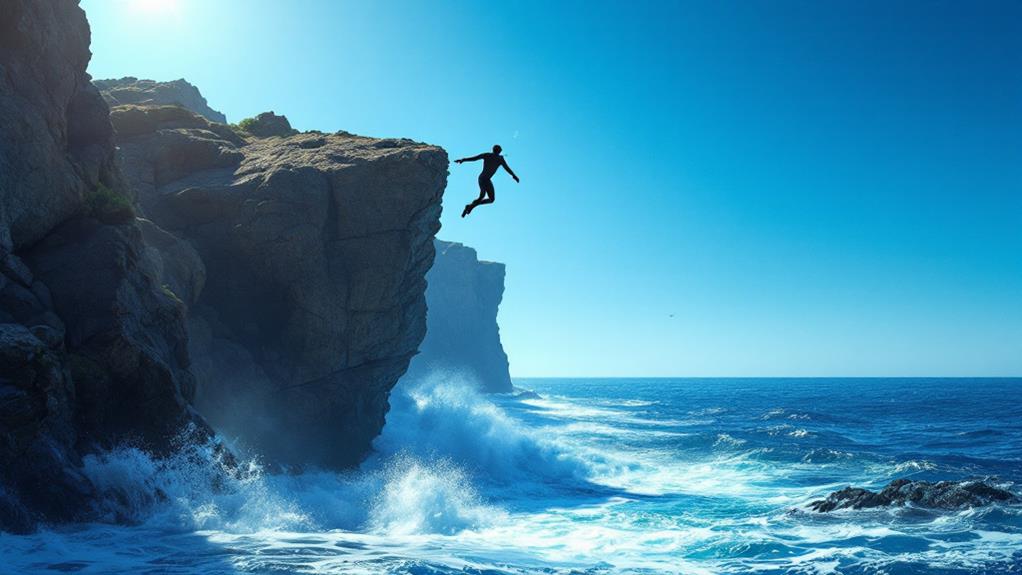
Height requirements set cliff diving and cliff jumping apart. When you're cliff diving, you'll typically be leaping from much greater heights than in cliff jumping. Cliff diving usually involves platforms or natural formations that are at least 20 meters (65 feet) high, with professional competitions often featuring heights of 27 meters (89 feet) or more.
In contrast, cliff jumping generally occurs at lower elevations. You'll find most recreational cliff jumping spots ranging from 5 to 20 meters (16 to 65 feet) in height. This lower altitude makes cliff jumping more accessible to a wider range of participants, including beginners and intermediate thrill-seekers.
The height difference significantly impacts the experience and required skill level. Cliff diving demands extensive training, precise technique, and often professional-level abilities due to the increased risks associated with higher jumps. You'll need to master proper form and entry to minimize the impact on your body when hitting the water at higher speeds. Cliff jumping, while still requiring caution and skill, is generally less demanding and allows for a broader range of diving styles and techniques due to the lower heights involved.
Technique and Form
The techniques and forms employed in cliff diving and cliff jumping differ significantly due to the varying heights and associated risks. In cliff jumping, you'll typically use a simpler technique. You'll often enter the water feet-first, keeping your body straight and your arms close to your sides. This position helps you maintain control and reduce the impact when you hit the water.
Cliff diving, on the other hand, requires more advanced techniques due to the greater heights involved. You'll need to execute precise aerial maneuvers before entering the water. A common form is the pike position, where you bend at the hips and grab your legs. This allows you to control your rotation and enter the water vertically, head-first. You'll also need to perfect your entry technique, using your hands to break the water's surface and create a clean, low-splash entry.
In both activities, you must pay attention to your body position throughout the jump or dive. Proper form is crucial for reducing the risk of injury and ensuring a smooth entry into the water. However, cliff diving demands a higher level of skill, precision, and body awareness due to its more complex techniques and increased risks.
Required Skill Levels
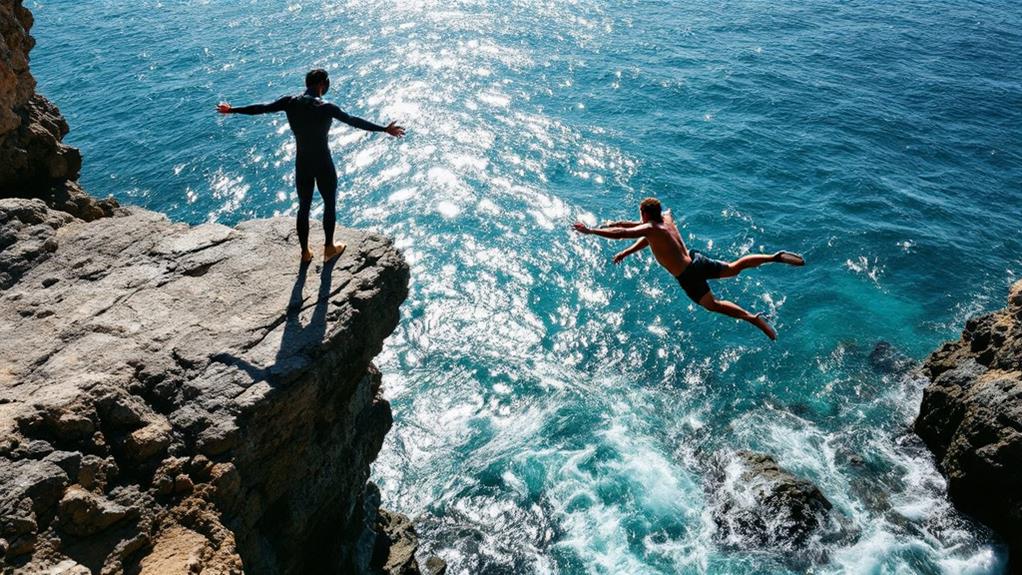
Cliff jumping and cliff diving call for vastly different skill levels. For cliff jumping, you'll need basic swimming abilities and a reasonable level of physical fitness. You should be comfortable in water and able to swim to safety after your jump. It's also important to have good judgment to assess the safety of the jumping spot and the water below.
Cliff diving, on the other hand, demands a much higher skill level. You'll need to be an expert swimmer with excellent body control and spatial awareness. Divers must have extensive training in acrobatics and diving techniques to execute complex maneuvers safely. You'll need to master various dive positions, rotations, and entry techniques to minimize impact and prevent injuries.
Additionally, cliff diving requires mental fortitude and the ability to stay calm under pressure. You'll need to overcome the fear of heights and maintain focus during your dive. Physical conditioning is crucial, as you'll need strength, flexibility, and core stability to perform dives correctly. Regular practice and gradual progression are essential for developing the skills necessary for cliff diving.
Safety Considerations
Safety's paramount importance in both cliff jumping and cliff diving cannot be overstated. You must always prioritize your well-being and take necessary precautions. Before attempting either activity, thoroughly inspect the landing area for potential hazards like submerged rocks or shallow water. It's crucial to know the water depth and ensure it's sufficient for a safe landing.
For cliff jumping, you'll need to consider:
- Proper technique for entry
- Wind conditions
- Your physical fitness level
Cliff diving requires additional safety measures due to its increased complexity:
- Professional spotters
- Proper training in acrobatics
- Knowledge of advanced diving techniques
Here's a comparison of safety considerations:
| Safety Aspect | Cliff Jumping | Cliff Diving |
|---|---|---|
| Height | Lower (10-30 ft) | Higher (60+ ft) |
| Water depth | 10-15 ft minimum | 15+ ft minimum |
| Landing technique | Feet first | Various (head first, rotating) |
| Equipment | Optional (life vest) | Required (specialized gear) |
| Training | Basic | Advanced |
Training and Preparation
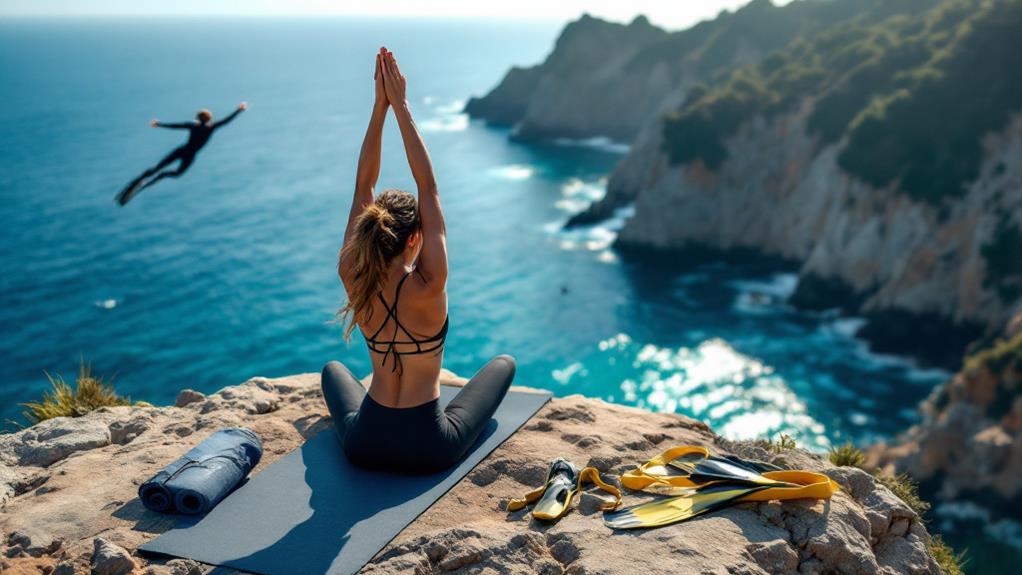
Proper training and preparation are key to enjoying cliff jumping and cliff diving safely. Before attempting either activity, you'll need to build your swimming skills and physical fitness. Focus on improving your core strength, leg power, and overall endurance through targeted exercises and regular swimming practice.
For cliff jumping, start with lower heights and gradually work your way up. Learn proper jumping techniques, including how to maintain body control in the air and enter the water safely. Practice spotting your landing area and judging distances accurately.
Cliff diving requires more extensive training due to its complexity and higher risk. You'll need to master:
- Advanced acrobatic skills
- Proper diving form and body positioning
- Mental preparation techniques for high-stress situations
Consider joining a cliff diving or high diving club to receive professional instruction. These organizations can provide structured training programs and access to safer practice environments. They'll also teach you how to assess water depth, identify potential hazards, and perform emergency procedures.
Competition Aspects
From a competitive standpoint, cliff diving and cliff jumping differ significantly. Cliff diving is a recognized competitive sport with organized events and governing bodies, while cliff jumping remains largely recreational.
In cliff diving competitions, you'll find standardized judging criteria, specific dive requirements, and height regulations. The Red Bull Cliff Diving World Series is the most prominent competition, featuring elite divers performing complex acrobatics from heights of up to 27 meters. Judges score dives based on take-off, execution, and entry.
Cliff jumping, on the other hand, doesn't have formal competitions. Instead, you might encounter informal gatherings or social media challenges where participants showcase their jumps. The focus is often on style, creativity, and location rather than technical precision.
| Aspect | Cliff Diving | Cliff Jumping |
|---|---|---|
| Competitions | Organized events | Informal gatherings |
| Judging | Standardized criteria | Subjective appreciation |
| Heights | Regulated (up to 27m) | Varied |
| Techniques | Complex acrobatics | Freestyle jumps |
While both activities involve leaping from heights, competitive cliff diving demands a higher level of skill, training, and adherence to specific rules. Cliff jumping offers more freedom but lacks the structured competitive environment of its diving counterpart.
Popular Locations Worldwide

While both cliff diving and cliff jumping enthusiasts can find breathtaking locations worldwide, some spots have gained legendary status. You'll find iconic cliff diving sites in places like Acapulco, Mexico, where professional divers perform death-defying leaps from La Quebrada cliffs. For cliff jumping, the Greek island of Navagio Beach offers stunning turquoise waters and towering limestone cliffs.
In Europe, you can't miss the Stari Most bridge in Mostar, Bosnia and Herzegovina, where annual diving competitions attract thrill-seekers from around the globe. The Hawaiian islands are a paradise for both activities, with Waimea Bay on Oahu and Ka Lae on the Big Island being popular destinations.
For the ultimate adrenaline rush, consider these extreme locations:
- Kaunolu, Lanai: This Hawaiian spot features a 80-foot jump into shark-infested waters.
- Kjragbolten, Norway: You'll leap from a boulder wedged between two cliffs, 3,200 feet above the ground.
- Rick's Cafe, Jamaica: Made famous by cliff diving scenes in movies, this spot offers jumps ranging from 10 to 35 feet.
Always prioritize safety and respect local regulations when exploring these locations.
Equipment and Gear
Equipment for cliff diving and cliff jumping is minimal but crucial for safety. You'll need a swimsuit that stays in place during impact, as loose clothing can cause injuries. For cliff diving, you might opt for a specialized diving suit that provides extra protection and reduces water friction.
Proper footwear is essential. Water shoes or neoprene booties protect your feet from sharp rocks and provide grip on slippery surfaces. They also cushion your feet during water entry.
A helmet is a must-have for both activities, especially when diving or jumping into unfamiliar waters. It protects your head from potential impacts with hidden rocks or debris.
For added safety, you should wear a life jacket or impact vest. These provide buoyancy and protect your torso from the force of impact with the water.
Other useful gear includes:
- Towels for drying off
- First aid kit for emergencies
- Waterproof camera to capture your experiences
- Dry bag to keep your belongings safe
- Sunscreen to protect your skin

